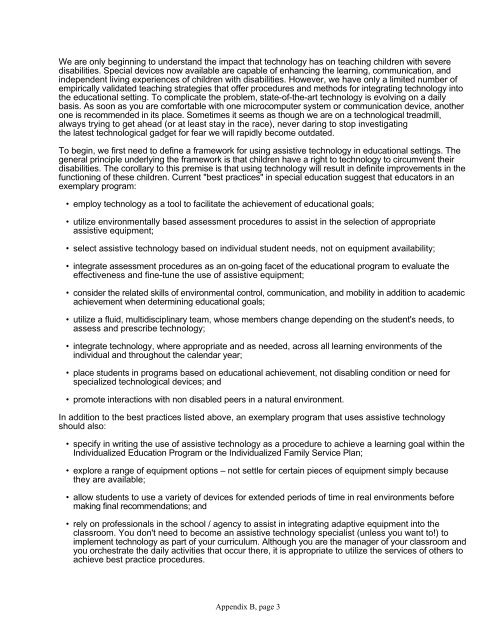Oakland Schools ASSISTIVE TECHNOLOGY GUIDELINES
Oakland Schools ASSISTIVE TECHNOLOGY GUIDELINES
Oakland Schools ASSISTIVE TECHNOLOGY GUIDELINES
You also want an ePaper? Increase the reach of your titles
YUMPU automatically turns print PDFs into web optimized ePapers that Google loves.
We are only beginning to understand the impact that technology has on teaching children with severe<br />
disabilities. Special devices now available are capable of enhancing the learning, communication, and<br />
independent living experiences of children with disabilities. However, we have only a limited number of<br />
empirically validated teaching strategies that offer procedures and methods for integrating technology into<br />
the educational setting. To complicate the problem, state-of-the-art technology is evolving on a daily<br />
basis. As soon as you are comfortable with one microcomputer system or communication device, another<br />
one is recommended in its place. Sometimes it seems as though we are on a technological treadmill,<br />
always trying to get ahead (or at least stay in the race), never daring to stop investigating<br />
the latest technological gadget for fear we will rapidly become outdated.<br />
To begin, we first need to define a framework for using assistive technology in educational settings. The<br />
general principle underlying the framework is that children have a right to technology to circumvent their<br />
disabilities. The corollary to this premise is that using technology will result in definite improvements in the<br />
functioning of these children. Current "best practices" in special education suggest that educators in an<br />
exemplary program:<br />
• employ technology as a tool to facilitate the achievement of educational goals;<br />
• utilize environmentally based assessment procedures to assist in the selection of appropriate<br />
assistive equipment;<br />
• select assistive technology based on individual student needs, not on equipment availability;<br />
• integrate assessment procedures as an on-going facet of the educational program to evaluate the<br />
effectiveness and fine-tune the use of assistive equipment;<br />
• consider the related skills of environmental control, communication, and mobility in addition to academic<br />
achievement when determining educational goals;<br />
• utilize a fluid, multidisciplinary team, whose members change depending on the student's needs, to<br />
assess and prescribe technology;<br />
• integrate technology, where appropriate and as needed, across all learning environments of the<br />
individual and throughout the calendar year;<br />
• place students in programs based on educational achievement, not disabling condition or need for<br />
specialized technological devices; and<br />
• promote interactions with non disabled peers in a natural environment.<br />
In addition to the best practices listed above, an exemplary program that uses assistive technology<br />
should also:<br />
• specify in writing the use of assistive technology as a procedure to achieve a learning goal within the<br />
Individualized Education Program or the Individualized Family Service Plan;<br />
• explore a range of equipment options – not settle for certain pieces of equipment simply because<br />
they are available;<br />
• allow students to use a variety of devices for extended periods of time in real environments before<br />
making final recommendations; and<br />
• rely on professionals in the school / agency to assist in integrating adaptive equipment into the<br />
classroom. You don't need to become an assistive technology specialist (unless you want to!) to<br />
implement technology as part of your curriculum. Although you are the manager of your classroom and<br />
you orchestrate the daily activities that occur there, it is appropriate to utilize the services of others to<br />
achieve best practice procedures.<br />
Appendix B, page 3
















